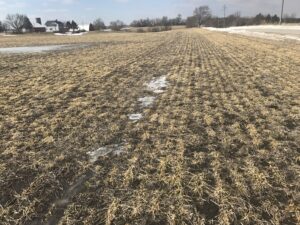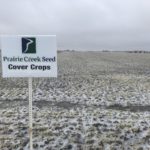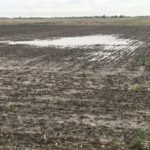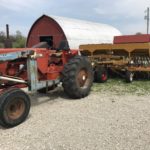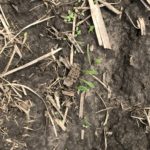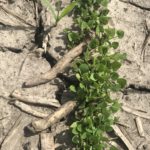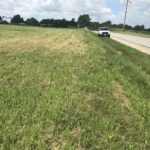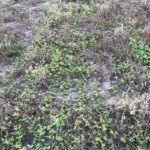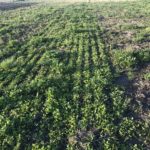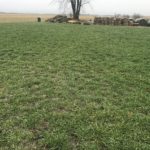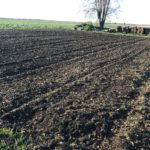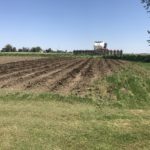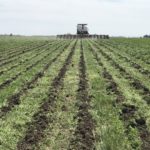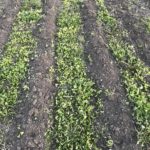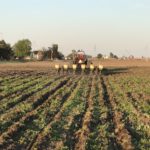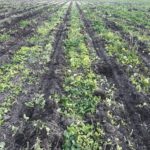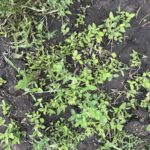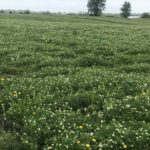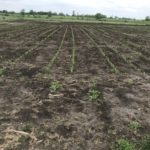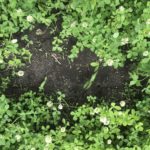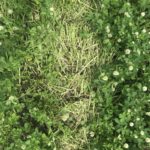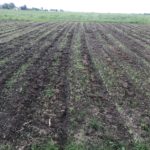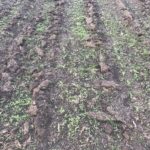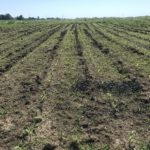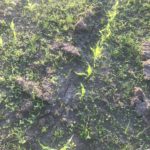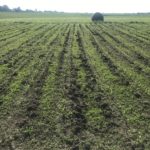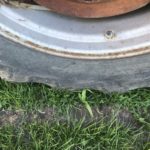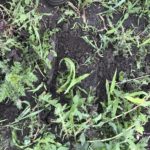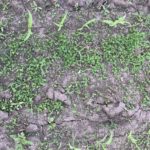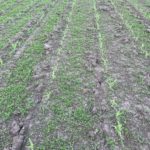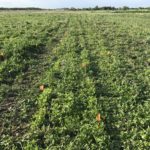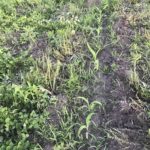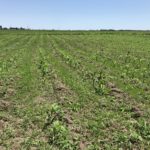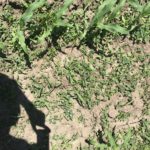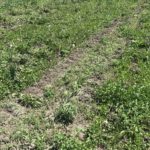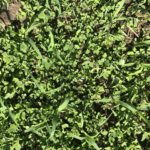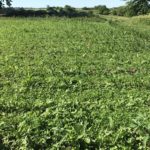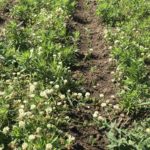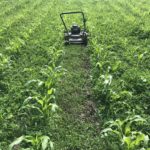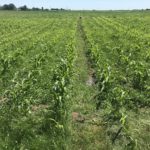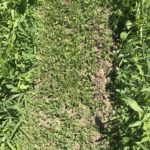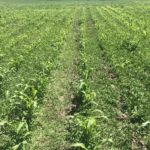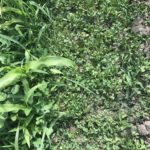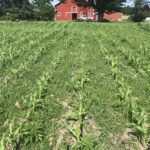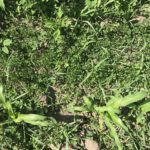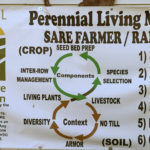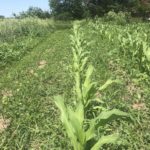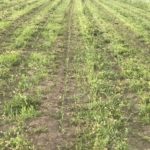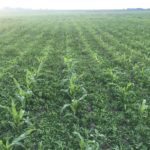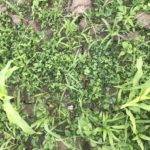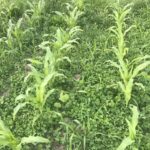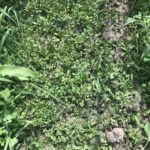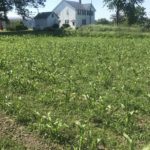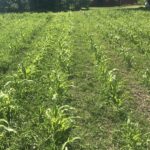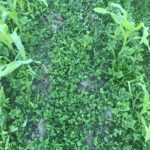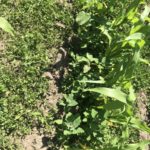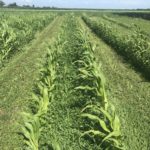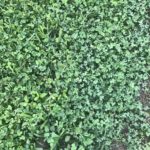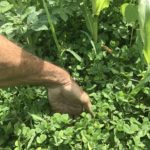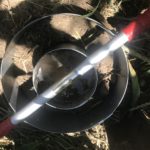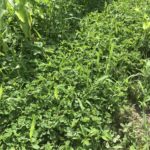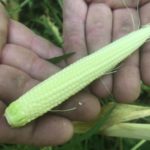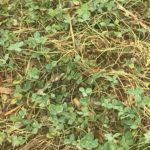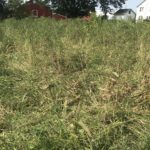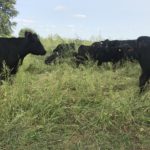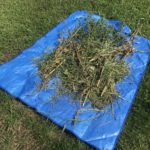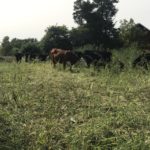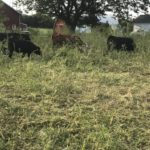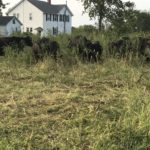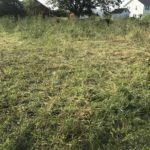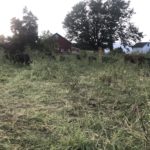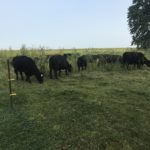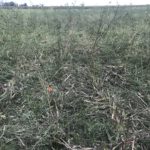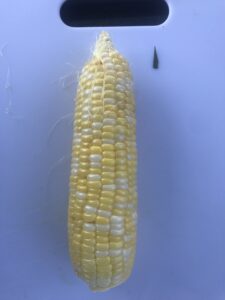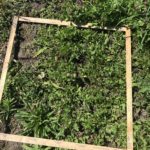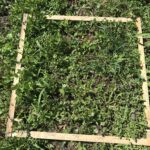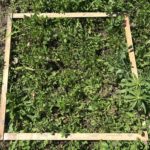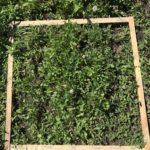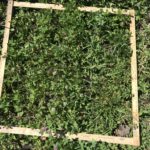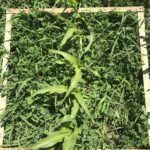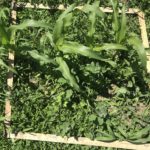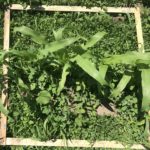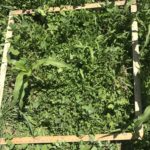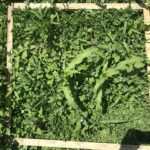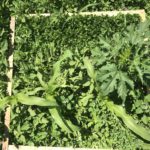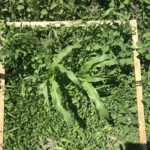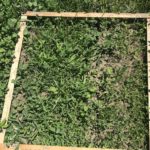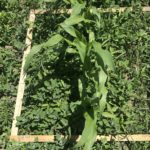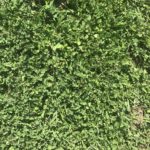Final report for FNC19-1178
Project Information
Prior to the beginning of the SARE project, a diverse multi-species winter-killed cover crop mix (Forage Max, now Forager) was obtained from Prairie Creek Seed (http://www.prairiecreekseed.com/) and no-till drilled into one acre of soybean stubble on September 17, 2018 using a John Deere 750 15-foot no-till drill owned by neighbor Knude Ullerup of Altona, Illinois. Due to the late planting the cover crop did not reach optimum growth and maximum cover. Resulting residue cover in the spring of 2019 was estimated at 10-20 percent at time of kura clover planting.
Kura clover living mulch systems have been shown to be an ecologically sound, effective weed suppression method in soybeans (Iowa State University, 2007; https://crops.extension.iastate.edu/soybean/production_kuraclover.html) and corn (Ken Albrecht, University of Wisconsin-Madison, 2007; https://crops.extension.iastate.edu/files/article/Experienceswithkuracloverlivingmulchcroppingsystems.pdf) under research conditions. However, Kura clover as a living mulch is slow to establish ("sleep stage"), presenting first-year weed control problems. After establishment, for organic farmers wanting to use living legume mulches, there are practical technical problems related to Kura clover suppression/control within the cash crop row without the use of conventional herbicides, as well as practical management of the Kura clover competition and height between the rows. This project proposes: 1) to establish Kura clover into one acre of a winter-killed cover crop/soybean stubble mix using a no-till drill to minimize first-year weed growth until the Kura clover fills in; then 2) use a tractor-mounted strip tillage tool (Orthman 1tRIPr strip tiller or comparable equipment; http://www.orthman.com/our-products.aspx?itemid=2048&pagetitle=1tRIPr) after establishment ("creep stage") to prepare a clean, clover-free uniform strip seedbed for sweet corn planting. Once the Kura clover is fully established ("leap stage"), 3) mechanical control of inter-row kura clover growth will be attempted using an inter-row crimper/roller tool from Walnut Creek Seeds, LLC (https://www.walnutcreekseeds.com/Dawn-Biologic.html), MacFarlane Mfg. of Madison, WI, Dawn Equipment in Illinois, an inter-row mower, weed mower, or comparable equipment.
Progress Report
2018 -- fall seeding of winter-killed cover crop mix in preparation for project beginning spring 2019
2018 site overview -- note highway proximity
2019 Activities
Twenty pounds of Kura clover seed along with species-specific inoculum was ordered through Prairie Creek Seed, Cascade, Iowa in early spring of 2019 (http://www.prairiecreekseed.com/). Prior to planting, the seed was also inoculated with a four-species blend of mycorrhizae obtained from Sustainable Ag Technologies (https://composttea.com/), adhered to the seed with water, organic molasses, and a dilute compost tea extracted from fresh bacterial/fungal compost of a Johnson-Su bioreactor (https://regenerationinternational.org/bioreactor/).
The recommended planting date in this area for Kura clover is the first week in May. Despite a cold wet spring that delayed most field operations, a warm dry spell during the first week of May permitted drying of the soil enough to allow no-till drilling of the inoculated Kura clover seed on May 16, 2019 @ 20 lbs/A seeding rate, along with a forage oats nurse crop using a Vermeer 15-foot 4-hopper no-till drill owned by neighbor Brad Williams of Victoria, Illinois and pulled by my tractor, a 1974 AC 180, 55 hp. The oat nurse crop was seeded at 50 lbs/A. The soil temperature ranged between 54 and 59 degrees, depending on the time of day. Because of the small seed size and low amount of seed compared to the hopper size, actual Kura seed dispersal was uneven. Manual brushing of the seed into the cups was necessary, and resulted in some cups running out before others. Nevertheless, the above-normal seeding rate (double the recommended 10 lb./A) gave a satisfactory emergence after six days in some areas. The overall result, however, was an uneven stand throughout the plot. Seedling emergence was noted on May 24, 2019. Heavy rains resumed about this time and continued through the rest of the month.
Record rainfall during the month of May, 2019 drowned out most of the Kura stand, resulting in sparse and sporadic survival. Clover does not like wet soils, and this is true for Kura clover as well. The oats cover helped wick out soil moisture but also shaded the Kura clover, which further delayed growth and development.
The rains did not stop in this area until the first week in June, 2019, and the ground was so soggy as to prevent any entry to the field without rutting or damaging the stand. Standing water remained in the Kura clover well into the first week of June. Consequently, no sweet corn was planted in the growing season of 2019 for this project. Other growers experienced the same problem, sweet corn was in short supply the entire summer, and many farmers were unable to plant field corn or soybeans at all and had to resort to planting summer cover crops through the USDA Prevented Plant program. The growing season of 2019 became a period of observation and learning.
The plot was periodically rotary mowed during the summer by neighbor Alan Haynes of Altona, Illinois using a John Deere 3-point hitch rear rotary mower mounted to a John Deere 4000 tractor. The mowing gave satisfactory weed and oats control but left residue bunched in areas, smothering some of the Kura stand. Flail mowing is recommended but a flail mower was unavailable except to purchase locally. A flail mower was not requested in the SARE budget.
Written notes and photographs were taken throughout the season. Some reddening and yellowing of the young Kura leaves was observed; plant tissue samples were taken and analyzed by TPS Agricultural Consulting and Laboratory out of Edinburg, Texas (https://www.tpslab.com/). Results came back showing deficiencies in potassium, sulfur, and nitrogen. Potassium sulfate was recommended as a foliar spray but I do not have a sprayer. The nitrogen deficiency was likely due to poor nodulation. Kura requires a species-specific Rhizobium inoculum. The pre-coated inoculum that came on the seed was likely old. More attention will be given to proper inoculation in the future. The plants outgrew the K-deficiency symptoms, so no potassium was applied. In the fall/winter of the 2019 season, 3 tons/A lime was applied by a commercial applicator to correct soil pH of 5.3.
2020 Activities
The winter of 2019-2020 turned out to be warm, dry, and mild. For the 2020 growing season, immediate neighbor and expert sweet corn farmer Jon Rollins participated by allowing me to take soil temperatures and other measurements, and compare sweet corn yields and quality in his conventionally-tilled plot to mine.
Beginning in early April, I placed soil thermometers underneath insulated, protected covers in the soil both in my plot and in Jon Rollins' field. Soil temperatures are discussed elsewhere in this report. Because of the spotty emergence, poor stand, and weak growth of the 2019 Kura planting, along with weed competition, a second, smaller plot (111 ft x 120 ft, 13,320 sq. ft. or .3 acre) was selected that had better drainage and less weed pressure. This plot had been seeded to a dense stand of perennial ryegrass that very effectively suppressed weeds. I learned from experience and online reading that Kura should be planted without a nurse crop and into a clean, weed-free seedbed. While this ran counter to my ag philosophy and project objectives, practicality prevailed, so I mowed once and rototilled the perennial ryegrass plot twice. I then had the Kura clover, along with dwarf white clover and dandelion, broadcast seeded and lightly raked into the soil. I added regular and dwarf white clover for faster germination and growth, and dandelion as a low-growing, deep-rooted perennial for species diversity. The seeding rate was as follows:
Kura = 10 lbs./A
White Clover = 5 lbs./A
Dwarf White Clover = 2 lb./A
Dandelion = 1 oz. for the entire plot (.3 acre)
On April 30, 2020, all species were broadcast seeded together. I specifically ordered fresh species-specific Kura clover inoculum separately and inoculated the Kura clover seed immediately prior to planting. For the white clovers, I also purchased white clover species-specific inoculum. I coated the seed by adding water mixed with honey, then stirred in the Rhizobium inoculum, mycorrhizae powder, biochar powder and a mineral powder using a shovel and mixing in a wheel barrow before loading the broadcast seeder. Emergence was noted by May 5, 2020. Weather turned cold for a few days around May 9. Soil temperature lows were 43 degrees F in the Kura mix plot, 44 degrees F in the Rollins' plot.
On May 9, the newly established Kura mix plot (hereafter referred to as the 2020 plot or stand) was strip-tilled into 8-inch strips on rows 30 inches apart with a Kuhn-Krause Gladiator 16-row strip tiller, using RTK-GPS guidance mounted to the tractor. Youngquist Ag Services of Cambridge, IL. provided this service free of charge, for which I am very grateful. Considering strip-tillers are not generally designed for strip-tilling into living plant or sod-like conditions, the result was very satisfactory. Youngquist admitted strip-tilling into a living mulch was a first for him. Soil conditions at the time of strip-tilling were ideal, leaving seedbed strips with good soil moisture and crumb. The emerged Kura mix did result in some heavy clodding and clumping due to the root systems of the clovers. A tine harrow could have smoothed out the clods and the soil surface, but I did not have access to one.
On May 10 a rain prevented planting until the soil was allowed to dry out.
On May 12, Jon Rollins planted Ambrosia, Trinity, and Serendipity non-organic, untreated sweet corn varieties with his six-row John Deere planter mounted with Yetter brand row cleaners. The planter lined up with the strips well, the Yetter row cleaners moved any clods away from the strip, and Jon did an excellent job of guiding the planter, even without GPS. Given that he had never planted this way before, he is to be commended for his skill at planting on the centers of the strips. The only problem was, he had a six-row planter and the strip-tiller was a multiple of eight, which threw some of the rows off.
On May 19, the seeded mix in the 2020 Kura plot had emerged and was growing fast and uniform except for the tilled strips.
On May 20, the prototype inter-row crimper unit arrived on a semi trailer from the manufacturer. In the 2019 Kura plot volunteer balansa clover that had re-seeded from previous cover cropping seasons began to bloom and needed to be mowed to control it. While offering good weed suppression by itself, the balansa smothered all plants, including the corn and Kura clover in the 2019 Kura plot. It proved to be an interference and confounding factor in the 2019 plot where it was present. Elsewhere in the 2019 plot, the Kura plants began greening up after initial chlorosis.
On May 22, I tested the inter-row crimper unit. It did not align with the tractor wheel width, and swayed into the corn row. I purchased sway blocks from a local implement dealer to stabilize the lower arms, but the center link still had considerable play. It was also too heavy for the hydraulics. The tractor front wheels were also too close to the corn rows and needed to be adjusted more towards the center between the rows. Work on the tractor and implement adjustments, along with rainy weather, delayed field work by more than a week, having to order sway blocks and tools. The tractor front axle and front linkages were also difficult to adjust. The front axle needed to be jacked up. The nuts and axle slide on the 45-year old tractor were dirty, heavily rusted and needed to be sprayed and left overnight with a rust removal product. A neighbor had to torch one of the tie-rod nuts off, another nut was stripped and I had to purchase a new tie-rod nut and linkage. In the meantime, unable to get into the field with the crimper unit, the weeds grew quickly through both the 2019 and 2020 stands, especially in the tilled strips where the exposed soil and crusting from recent rains created an ideal seedbed for small-seeded weeds like foxtail, pigweed, lambsquarter, water hemp, and mares' tail.
On May 27 the volunteer balansa clover in the 2019 Kura planting was almost knee-high and in full bloom and completely suppressing all other plants, including the Kura clover. In fact, I learned from online reading that balansa clover is sometimes used for its spring weed suppression ability ("Weed suppression by seven clover species", https://acsess.onlinelibrary.wiley.com/doi/abs/10.2134/agronj2001.934820x ; Balansa Clover, https://forages.oregonstate.edu/forages/balansa-clover; ISU weed suppression research, https://fixationclover.com/pin95-weed-suppression-not-a-problem-illinois-state-university-il/).
On May 29 my neighbor flail-mowed the balansa clover in the 2019 Kura planting, no charge. The emerged corn in that field was hidden beneath the balansa and was weak and etiolated. The flail-mower passed over the corn but did not remove the growing points. The corn was only 3-4 inches high at the time.
On May 31, I finished repairing and adjusting the tractor and inter-row crimper unit.
On June 1, 2 and 3, rain and high damaging winds prevented entry into all fields.
On June 4 I performed a test run of the inter-row crimper unit on both the 2019 and 2020 plots. Some of the weeds were crimped but the grassy species (foxtail) rebounded. Mornings were better for crimping the turgid broadleaf stems, which then dried out in the afternoon sun. The inter-row crimper unit could not be adjusted closer than 4 inches to either side of the corn rows, leaving at least 8 inches of weeds in the corn row. Because of the uneven spacing in the rows due to the six-row planter versus eight-row strip tiller, some of the rows in both the 2019 and 2020 plots could not be crimped. The inter-row crimper unit was effective at crimping the balansa clover between the rows because the balansa stems are hollow and wilt and dry easily once crimped. The balansa, however, along with any other weeds in the row, remained a problem.
On June 6 my neighbor flail-mowed the remaining volunteer balansa clover in the 2019 Kura plot because it had re-grown enough to begin to shade the corn rows.
On June 9 rain and wind from the hurricane moving up from the Gulf delayed field work, especially crimping. Rapid weed growth was occurring after the balansa mowing in the 2019 Kura plot, as well as in the 2020 Kura plot. The dense cover crop stand in the 2020 plot was not enough to prevent weeds from coming up through the cover in between the rows, and weeds were even taller in the row. Anticipated regrowth of the Kura clover after strip tilling to cover the bare soil in the strip did not occur. Conventional living mulch researchers use herbicide in the strips to control weeds. I was counting on rapid regrowth of the Kura clover in the 2019 plot and Kura combined with white clover in the 2020 plot, but it didn't happen.
On June 12 I adjusted the inter-row crimper unit to get as close to the corn rows as possible and driving slowly in low gear, I took out only a few corn plants. Guiding the tractor so close to the rows, I had to be very attentive, and the crimper still left all the weeds in the row, both 2019 and 2020 plots. Weeds were so dense I had to resort to other alternatives. Other researchers had used push mowers between the rows of their small plot research, so for the remainder of the growing season I relied on inter-row push mowing, and later, a weed mower, as well.
On June 14 I used my 42" riding mower on a few rows, taking out every other row in the 30-inch row spacing. I did this for a few rows in both the 2019 and 2020 plots. I set the mower at 3-inch cutting height and was able to get to within two to three inches from the corn row. This was closer than the crimper but still left many weeds in the row. A riding lawn mower is not designed for agricultural field work, and the rough cloddy soil surface damaged the mower deck and blades.
On June 16 I took the riding lawn mower to the local John Deere implement dealer to repair and adjust the mower. I had to leave it at the dealer for several days.
On June 17 I noticed the sweet corn was curling in the hot weather, just as the corn was beginning to tassle and set ears. The corn looked very stressed from the combination of heat and weed pressure.
On June 18 I went back to using the inter-row crimper unit in the 2019 Kura plot. I crimped twenty rows, taking out some corn if I was not intensely concentrating on steering the tractor. The rear tires of the tractor allowed only two free inches from either row in between the corn rows. The corn was getting taller and leaves were getting caught in the tractor or crimper, and I had to drive very slow, about the same speed as when first-pass shovel-cultivating with a mounted cultivator. I wish I had seen the MSU video sooner by Dan Brainard using a SARE grant to study in-row finger weeders and in-row flex-tine weeders from 2018 (https://www.youtube.com/watch?v=4rQQ7iNk2-o). Reportedly it works better on transplanted crops, though.
On June 19 and 20 rain, thunder and lightning kept me out of the plots.
On June 21 I observed the weeds re-growing from the mowing in the the 2020 Kura plot.
On June 22 there was more rain, thunder and lightning. 1.1 inches of rainfall total were recorded.
On June 23 I observed the weeds growing back fast but too wet to get into the fields.
On June 24 the riding mower was returned from the implement dealer. I took photos of the plots. The crimped rows have sprung back up.
On June 25 I mowed some of the rows that were still available in the 2020 Kura plot. Taking out every other row with the mower is leaving fewer rows.
On June 26 and 27 intermittent rain kept me out of the plots.
On June 29 I purchased a self-propelled, rear-discharge push mower with a 22-inch cutting width and 28-inch deck width. This saved rows and was able to get within 1-2 inches of the row and mow lower. Weeds by this time were 15-18 inches high, and dense. The new clover planting in the 2020 Kura plot had been densely shaded. The push mower did a much better job and mowed the clover/weed mix to 2 inch height. It was slow, tedious work and the rough ground was still hard on the mower, which was not designed for this type of mowing. Repeated frequent mowings in the 2020 plot kept the weeds under control in the remaining rows except those too narrow for the mower to get through.
On July 6 I mowed the 2020 Kura plot again.
On July 13 I met with Scott Hennenfent, professional printer in nearby Altona, to discuss a banner for display in front of the 2020 Kura plot: size, font, color and cost.
On July 14 I rented a 27-inch weed mower to manage late weeds in the 2019 Kura plot. The mare's tail was head high and dense. The corn in the 2019 plot had not matured, few ears developed. Delayed weed management due to tractor and crimper problems early in the season without a backup management plan created even more problems later in the season.
I also learned about a farmer in Missouri who had developed a farmer-built open source multi-row inter-row mower:
https://projects.sare.org/project-reports/fnc18-1134/
I contacted the gentleman in Missouri because it seemed to be the exact machine I was looking for. He commented that he did have a few weeds in the row, and that the machine required more horsepower than the tractor I have. It's a good idea for the future.
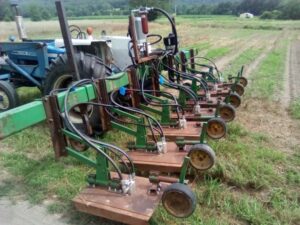
On July 17 I took videos of the best parts of the field and cover crop stand between the rows. I then took soil samples from Jon's control area, the 2019 and 2020 Kura plots, and shipped them to Ward Labs in Kearney, NE for microbial analysis and Haney tests. I took infiltration measurements in both the control plot and 2019 and 2020 Kura plots, documented the field again with photos and videos, then I had a nearby neighbor disc-mow, rake and round-bale the corn, weeds, and clover in the 2019 Kura plot for bedding and to remove as many weed seeds as possible.
From July 19 through July 27 there was intermittent rain and thunderstorms.
From July 28 through August 7, I measured soil infiltration rates, soil analysis, and sweet corn samples . The results, along with spring soil temperatures, are presented in the Results and Discussion section.
On August 4, I measured sweet corn from the Rollins' control plot and 2020 Kura plot for length, width, fresh ear weight, and leaf and ear dissolved sugar content, as indicated by brix, or refractive index as viewed by a hand-held refractometer:
(https://perfect-blend.com/pdf/Brochures/Brix.pdf) See the chart for typical brix numbers for sweet corn.
Leaf sap brix is a measurement of the overall health of the plant at sampling time, and is an important indicator of the level of environmental stress (heat, drought, pests, nutrients, etc) the plant is undergoing.
On August 10, heavy rain, thunderstorms, high damaging wind and a power outage delayed work.
On August 11, I spoke with neighbor Jon Rollins about the idea of post-harvest grazing his cattle onto the 2020 Kura plot. He will not be available for two weeks.
On August 19th I submitted a press release/news article to the Knox County SWCD newsletter and the Galesburg Register Mail "Farmers Forecast" insert for publication. Both were accepted, printed and made available online:
On August 21 S & S Fencing out of Canton IL installed a two-strand electric fence on insulated T-posts around the perimeter of the 2020 Kura plot.
On September 1 I received the soil test results from Ward Labs. Results are in the Results and Discussion section below.
From Sept 7 through September 13, intermittent heavy rains prevented turnout of the cattle onto the 2020 Kura paddock.
On September 14, Jon Rollins turned twelve cattle onto the Kura paddock early. I was able to take only one pre-graze biomass sample using a yard-square quadrat, removing the biomass down to just above ground level to avoid dirt, before they began eating. Time in: 8:00 AM; Time out: 7:30 PM = 11.5 hours graze time. They readily grazed weeds and stalks as well as remaining green cover crop. By the end of the day it was about a third eaten down. I air-dried the sample for two-weeks in the basement using a fan for continuous air flow.
On September 15, the cattle were brought back onto the 2020 Kura paddock. Time in: 10:00 AM; Time out 7:30 PM = 9.5 hours graze time. They ate right up until dark. I wanted one more day of grazing to finish up but Jon thought better.
On September 19 I took three post-graze samples of the remaining forage using a 1-yard quadrat, air drying with forced-air ventilation (fan) in the basement. The results are anecdotal only, not for scientific reference.
On October 18, 2020 I mowed the remaining plant material in the 2020 Kura paddock with a riding lawn mower set to 3-inch cutting height. This ended my outdoor activities for the project.
Final Report Summary -- March, 2021
Comprehensive Summary: Kura clover was no-till drilled into a winter-killed cover crop in the spring of 2019 and seeded as a mix with white clover and dandelion into a rototilled, weed-free, lightly raked seedbed in the spring of 2020. The 2020 method resulted in a more uniform, satisfactory stand. After emergence, both plots were strip-tilled with a Kuhn-Krause Gladiator strip tiller for sweet corn seedbed preparation. A neighbor's conventionally managed sweet corn plot served as a control/comparison. Sweet corn was planted on May 12, 2020 with the intention of using a prototype inter-row crimper unit to suppress weeds and cover crop between the rows. The rhizomatous Kura clover was expected to grow back into the row to suppress in-row weeds. Neither was effective: tractor and crimper unit modifications early in the summer delayed entry into the field and allowed the weeds to overtake the corn. Similarly, the annual weeds grew faster than the Kura clover in the row. A riding mower, a push mower, and a weed mower gave limited weed control between the rows. As a result, only a few ears in the 2020 Kura plot reached maturity. Overall size and weight of those ears that did reach maturity was reduced, compared to the neighbor's control plot, but were comparable in sugar content (brix). Later in the season a livestock grazing component was added to the project to determine the feasibility and palatability of the sweet corn stover/Kura clover/weed mix. Air-dried pre-graze and post-graze samples were taken to determine the amount grazed on a per-acre basis. A net forage removal of 5183 lbs/A. over a two-day grazing period was realized. Soil health parameters of infiltration rate and soil microbial analysis as measured by Ward Laboratories of Kearney, NE suggested overall greater soil porosity and soil microbial health in the perennial living mulch system. After the project an important piece of information was learned: independent research indicates negative interactions between understory cover crops and corn due to wavelength changes in the light reflecting into the crop canopy from the cover crop, even at early stage of corn emergence and growth. Future research and development points towards improvements needed in weed control in the crop row, better mechanical control between rows, and overall, a better understanding of the complexities of crop/cover crop/weed interactions.
The Problem Addressed: Tillage and herbicides for weed control in conventional systems are leading to soil erosion, degradation, and herbicide-resistant superweeds. A more ecological solution based on cover cropping, soil conservation, and regenerative agricultural principles is needed.
The Solution Pursued: Weed suppression through perennial living mulch species in row crops offers a potential alternative solution. Perennial living mulch species are long-lived, need only preliminary and minimum tillage, can form a dense cover, and can provide soil-holding and soil-building advantages to the farmer. Strip-tilling into an established perennial living mulch species like Kura clover (Trifolium ambiguum) to provide a narrow, clean seedbed for the corn rows allows cash crop production with minimum soil disturbance and optimum soil stabilization and erosion control.
Research Approach (Methodology): The methodology employed closely followed those of leading researchers in Kura clover at Iowa State University, University of Wisconsin, University of Minnesota, and others: establish the clover; create a suitable seedbed for the corn rows; and manage weeds until corn maturity. The differences were: a) I did not have three years for full Kura establishment; b) I did not want to use herbicides to spray a clean strip for the corn; and c) I wanted to try a prototype inter-row crimper unit instead of mowing, as other researchers had done, for weed management. The inter-row crimper unit was ineffective at weed control, but my methodology helped to push the information envelope towards a more sustainable option.
Educational Approach: Educational dissemination was accomplished with press releases to local newspapers/organizations. Two such media outlets printed the press release as hard copy and online. An educational online Youtube video was also produced and uploaded.
Farmer Learning Outcomes: There were no known direct farmer learning outcomes.
Succinct Statement of Research Conclusions: For the 2020 growing season, first or second-year Kura clover or mixed Kura/white clover inadequately suppressed weeds in a sweet corn/clover perennial living mulch system, resulting in reduced growth and yield of the sweet corn. Soil microbial analysis suggests long-term improved soil conditions and increased soil infiltration in the clover perennial living mulch system compared to conventionally-grown sweet corn in a nearby location under similar soil and growing conditions.
Farmer Adoption Outcomes: There were no known farmer adoption outcomes.
My project objectives:
1) To successfully establish a dense stand of Kura clover, dwarf white clover and dandelion as a perennial living mulch;
2) To strip-till the established Kura mix and interseed sweet corn into the strip tilled living mulch;
3) To test out a prototype inter-row crimper unit to manage weeds or any aggressiveness in the growth or spread of the Kura clover;
4) The proposed demonstration site is adjacent to a state highway, so I will promote the project by posting signs for passersby;
5) To document the project through photographs/video, take spring soil temperatures, estimate weed density and suppression by the Kura species mix, measure infiltration rates, conduct soil tests, take ear yield and quality measurements, and issue a press release to the media.
Addendum -- February 15, 2020
Having learned from NRCS soil conservation principles (https://www.nrcs.usda.gov/wps/portal/nrcs/detailfull/nd/soils/health/?cid=nrcseprd1300631) and innovative regenerative practices of the importance of multi-species diversity in cropping systems, especially cover crops, and the value of inter-species interactions above and below ground, I have modified the first objective to include other perennial low-growing species, notably bluegrass, dwarf white clover, dandelion, chickweed, plaintain, balansa clover, among other, to be planted along with the kura clover in additional plots while keeping the existing kura clover stand. Since the original budget did not call for the additional species, I will pay for the seed out of pocket.
Recent research from the University Minnesota also shows strip tilling may not leave a wide enough strip to prevent competition between the kura clover and sweet corn. Instead, their findings indicated rotary tillage was more effective at creating a more suitable seed bed to optimize corn emergence while minimizing competition from the kura clover (https://www.mda.state.mn.us/optimizing-establishment-corn-cover-crops-and-living-mulches-maintain-yield-while-reducing-nitrate)
Therefore, the first two objectives are modified to:
- To successfully establish a dense stand of low-growing perennial mixed plant species featuring primarily Kura clover as a living mulch;
- To apply available equipment options (strip-tillers, rotary tillers, rotary strip tillers), with modifications as needed, to optimize sweet corn establishment while maintaining the kura clover stand.
Research
A. Process involved in conducting the project: Confronted with agricultural problems of soil degradation and erosion, water quality issues due to agricultural runoff, the rise of "superweeds" from herbicide resistance, and increasing agricultural input costs, the logic behind the choice to develop more sustainable perennial living mulch systems over annual monoculture tilled systems appears natural and self-explanatory.
Secondly, over fifty years of conventional monoculture agriculture has left my sixty acres of Highly Erodable Land (HEL) in a degraded condition, so I have a particular interest in any cropping system that will reduce erosion and increase soil health on my farm. I was already familiar with Kura clover as a persistent, resilient, multi-purpose perennial legume. I was guided to Kura clover research at Iowa State University by a fellow colleague from New Mexico State University. That research led me in turn to the work of Dr. Kenneth Albrecht from the University of Wisconsin, since retired. Inspired by Dr. Albrecht and his research on Kura clover in perennial living mulch systems with field corn, I hatched the idea of demonstrating some of that research on my own farm. Finally, having attended the Soil Health Academy (https://soilhealthacademy.org/) and knowing about soil conservation principles (https://www.jswconline.org/content/jswc/73/4/96A.full.pdf) of a) non-disturbance, b) armor or residue on the soil, c) microbial and plant species diversity, and d) keeping living plants in the ground as long as possible, I was motivated to apply these principles towards conserving the soil on my sixty acres of mostly Highly Erodable Land (HEL). The resulting process led to the core precepts in this project.
B. Specific Considerations -- Farmers wanting to apply this or a similar perennial living mulch cropping system to their operation should consider:
a) Doing a more thorough investigation than simply online reading and research and consult with as many researchers and company engineers as possible; literature searches are often more in scientific pubs than ordinary farm publications; use Google Scholar to access abstracts; the keywords may not be in ordinary online searchers;
b) Starting small -- Kura clover seed is expensive, and so is specialized equipment; garden-scale initially is less risky than field scale;
c) Partnering with neighbors -- it's good to have understanding, patient neighbors to help, especially when things go sideways;
d) Treating it as a "Risk Management Program" -- take small risks, not big ones; don't invest in expensive implements until they have been demonstrated to work under your conditions, not theirs;
e) Learning patience -- Kura takes three years to become fully established; maybe start with a cheaper, more reliable perennial mulch option like white clover, even though it has a bad reputation as a perennial ground cover for weed control (too rank);
f) Having a backup plan or option for each step;
g) Understanding it as a SYSTEM with its own particular timing and management considerations; and
h) Being flexible in your outlook and practice. The ones most successful with PGC systems are conventional growers who have their management strategy down already, THEN transitioning to organic through input substitution and adjusting the existing cropping practices.
Materials and Methods
2020 - a) Ordinarily, no-till planting into a mulch, living or dead, is important for organic weed control if mechanical or chemical options are limited. However, unsatisfactory personal results from no-till seeding Kura clover in 2019 coupled with information obtained online and from experienced farmers indicated greater success by planting small-seeded, slow growing perennial legumes into a tilled, clean seedbed and lightly harrowing or raking in. This proved more effective in the 2020 Kura plot, where the clover emergence was more dense and uniform, and annual weed seedlings could be mowed along with the clover.
b) After reviewing and comparing organic seed costs to conventional seed costs, I resorted to conventional untreated seed for cost savings. Fortunately, I needed the cost savings to apply to other unexpected expenses.
c) Kura clover can grow 10-12 inches in a season (Dr. Kenneth Albrecht, personal communication, 2019), so I was counting on the Kura clover filling in. I was NOT counting on the tilled strips being ideal conditions for small-seeded annual weeds growing in bare, disturbed soil after a rain and before the corn emerged. The weed seeds quickly outgrew the Kura clover and took over the tilled strips.
d) The inter-row crimper unit was not designed for my smaller, older tractor, especially with no GPS; theoretically it could have worked with a more suitably matched modern tractor with GPS and more horsepower. The same holds for the open-source inter-row mower design from the 2018 SARE project.
e) In my experience the three critical factors to consider in the materials and methods were: a) corn seedbed preparation methods (organic herbicide strips, strip tillling, rotary tilling or planter-mounted no-till row cleaning attachments); b) weed management options (crimping, mowing, flaming, electric zapping, shielded herbicide spraying or other method); and c) timing -- matching the establishment/growing periods of each element -- crop, ground cover, and weeds -- with a particular management/cultural practice. For example: mow or crimp before or after crop emergence? Strip till before or after a rain?
f) I learned after the project that research findings point toward the red light shift reflecting from a green cover crop onto corn, even emerging corn seedlings, will significantly detract from full development and yield. This may mean that either some suppression/control resulting in a brown color early on until the corn is at a later stage, or accepting lower yields as a tradeoff for soil health/resiliency. This dilemma has yet to be resolved and may point towards a future where price supports or "conservation credits" for more sustainably-grown crops in order to offset both yield reductions and hidden environmental/social/health costs.
For a more detailed understanding of crop/cover crop interactions, refer to: https://www.abe.iastate.edu/pgc-team/pgc-farmer-workshop/
for Perennial Ground Cover research information.
Results:
- Soil temperatures --
SARE KURA project FNC19-1178 2020 soil temperatures (degrees F)
Date Control (Rollins) Kura (Field) 4-21 48 44 4-23 53 50 4-30 48 48 5-09 44 43 5-14 50 50 5-19 48 48 5-20 50 50 5-25 68 66 Av. 51.1 49.9 Average soil temperature over the period recorded was slightly lower in the Kura plot compared to the (bare) conventional plot. Early spring temperatures were noticeably warmer in the control plot.
- Soil infiltration --
SARE KURA project FNC19-1178 soil infiltration (year 2020, units as noted)
Rep Control (Rollins) Kura 2019 Plot Kura 2020 Plot 01 12 min. 1.1 min. 43.41 sec. 02 26 min. 5.29 min. 8.38 sec. Av. 19 min. 3.2 min. 25.9 sec. - Soil tests -- Microbial analysis -- for the full report refer to: file:///C:/Users/Charles/Downloads/Biological2_20200803.pdf
Soil analysis results code: 01J = Jon Rollins control; 02K = 2019 Kura plot; 06G = 2020 Kura plot
For full professional definitions and explanation of the role of soil bacteria, refer to: https://ohioline.osu.edu/factsheet/anr-36
For this project, I considered Phospholipid fatty acid (PLFA), diversity, Microbial Active Carbon (MAC), organic matter (OM), and overall Soil Health Index (SHI) to be the most important factors to look at; NOTE: these numbers should be used for comparison purposes over time; one test is only a snapshot of a moving picture; As Ohio State University Extension states:
The Soil Health Index is "calculated based on soil respiration and water extractable carbon and nitrogen. This score can be used to compare that specific soil location over time or compare between different site management practices. The goal is to improve the soil health score by utilizing soil building practices such as no-till and cover crops." (https://agcrops.osu.edu/newsletter/corn-newsletter/2019-07/haney-test-soil-health#:~:text=The%20Haney%20test%20uses%20unique,organic%20nitrogen%20and%20their%20ratio.)
SARE KURA project soil microbial analysis (year 2020):
| Category | Control (Rollins) | Kura 2019 Plot | Kura 2020 Plot |
| PLFA | 620.74 | 980.48 | 4599.6 |
| Diversity | 1.48 | 1.54 | 1.5 |
| F:B | .44 | .47 | .39 |
| +/- | 2.4 | 1.62 | 2.94 |
| S/U | 4.08 | 1.73 | 2.67 |
| M/P | 11.1 | 7.82 | 3.45 |
| Pre16 | 2.1 | 3.1 | 1.88 |
| Pre18 | .85 | 6.9 | All cyclo |
| MAC (Microbial Active Carbon) | 86.2 | 155.5 | 148 |
| Soil Respiration | 102.9 | 167.5 | 184.8 |
| OM (%) | 4.8 | 6.0 | 6.1 |
| SHI (Soil Health Index) | 12.2 | 17.1 | 19.1 |
4. Sweet Corn Measurements
SARE KURA sweet corn average measurements
Units as noted, average of five; yield not available
| Leaf Brix | Ear Brix | Ear Length (cm) | Ear Diameter (cm) | Wt (oz) | |
| Control (Rollins) | 10.6 | 24 | 21.0 | 4.5 | 9.42 |
| Kura 2020 | 10.0 | 24.6 | 16.3 | 4.4 | 7.5 |
Ear weights were significantly reduced in the Kura plots, probably because of competition from weed pressure.
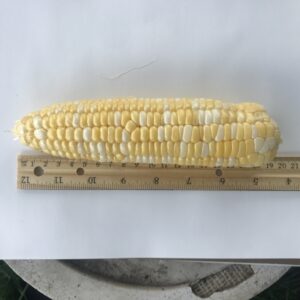
2020 Kura plot ear example
5. Post-harvest Forage Dry Matter Weight (DMW)
SARE Kura forage DMW
(Pre-graze: one measurement only; post-graze: average of three samples, lb. per Acre)
| Pre-graze | Post-graze | Net wt |
| 14,500 | 9,317 | 5,183 |
6. Weed densities
Early weed densities per one-yard quadrat were photographed and visually estimated via close-up inspection on June 11, 2020 in the Kura 2019 plot and on June 15 in the Kura 2020 plot. Weed density was inversely proportional to Kura plant density. Therefore, photos are listed according to Kura density estimates. HOWEVER, weeds were able to grow through and above the clover stand at all times. Sheer Kura density made a difference. Later weed densities were too great to measure. The spring-seeded clover in the 2020 Kura plot did not establish quickly enough to make a difference in the weed density or size. Mowing controlled weeds between the row only. The control (Rollins' plot) had no measurable weed pressure after cultivation until after lay-by. Late-season weeds in the control were present but not detracting from ear yield, size, fill, or quality.
2019 Kura plot:
2020 Kura plot
Under close inspection, note the presence of clover under the weed canopy and the uniform density of clover in certain areas after the weeds were mowed early.
Educational & Outreach Activities
Participation Summary:
- Via personal communication and field visits to the farm, I consulted with organic farmer/neighbor Andrew Bowman.
- Via telephone conversation I consulted with Brandon Schlautman, Lead Scientist and Kura clover breeder, The Land Institute, Salina, KS
- Press release in local newspaper insert "Farmers' Forecast", Galesburg Register Mail, and online: https://www.galesburg.com/story/business/agricultural/2020/11/17/pioneering-perennial-living-mulch-systems/114971694/
- Knox County Soil and Water Conservation Newsletter, August, 2020: file:///C:/Users/Charles/Pictures/2020/sare%20kura/000Knox%20Newsletter%20August%202020%20(reduced%20pdf)%20SARE.pdf
- Youtube video: SARE Youtube channel: https://youtu.be/SF2fxIlrP3E
Learning Outcomes
Lessons I personally learned:
- Choose "Quality" seed of a known variety (not VNS) and purity;
- Have all soil amendments applied and incorporated prior to planting;
- Buy FRESH species-specific inoculum (not pre-coated), keep in a cool place (refrigerator) until the day of planting;
- Inoculate as close to planting time as possible;
- Seed Kura clover into a tilled, weed-free, firm seedbed, broadcast or shallow-drilled, lightly covered; This practice has been confirmed by a researcher experienced with Kura clover: "We have very low success no-till drilling kura clover in an organic system. In a conventional system we can use a few different herbicides to keep weeds at bay, but it is still not perfect. Lots to learn here, very interesting to learn about your experiences, which seem to corroborate well with mine here. The challenge for us is that many of the bigger conventional growers (especially in KS) would not be willing to adopt this system if it required tillage for kura clover establishment."
- One neighboring farmer commented:
- "Livestock integration up front is necessary. There needs to be a revenue stream to sustain transition until the Kura is well established.
- The cover must get quite tall prior to flailing to achieve good weed control."
Project Outcomes
A couple of months after the online press release describing my perennial living mulch project with Kura clover, I received an email from a Kura clover researcher in Kansas (two states away) who had read the press release and was interested in learning more. As it turns out, he has been part of a Perennial Ground Cover working group made up of researchers and farmers committed to increasing agricultural sustainability in the Midwest through research and development of perennial living mulch systems. I was introduced to a number of brilliant scientific minds at major agricultural universities, NGOs, and agribusinesses who understood the urgency of developing perennial living mulch systems and the promise of increased agricultural sustainability without profit losses. Through continued communication and thoughtful discussions and exchange of ideas, they also helped me understand the subtle complexity of this new system, the importance of timing and knowledge of crop/weed/living mulch interactions. Importantly, I learned light reflecting onto corn from green cover crops significantly reduces corn yield.
Recommendations for future study:
- In-row mechanical weed options: finger weeders, tine weeders (in-row), modified cultivator sweeps (in the tilled crop strips);
- Organic herbicide for pre-plant cover crop and weed control/suppression;
- Narrow-row corn rows (15-inch or narrower) for earlier canopy closure;
- Corn breeding for polyculture systems. Currently, most commercially available corn has been bred for monoculture production;
- Perennial living mulch systems research using non-conventional living mulch species: ornamental ground covers, creeping flowering ornamentals, decumbent "weeds" i.e. chickweed, henbane, malva, cheeseweed, broadleaf plantain, carpetweed and others;
- Research on compatible perennial crop species: asparagus, Jerusalem artichoke, Kernza, for example
Comments for SARE:
- Funding, grants, or sponsorship of a PGC (perennial ground cover) conference focusing specifically on research, challenges and opportunities in perennial living mulch/perennial cropping systems;
- Hosting an online group or email list to bring farmers and researchers together to discuss issues of PGC systems.
Information Products
- Video: Strip-Tilling Corn into a Perennial Living Mulch with Andrew Bowman and Charles Martin (Conference/Presentation Material)
